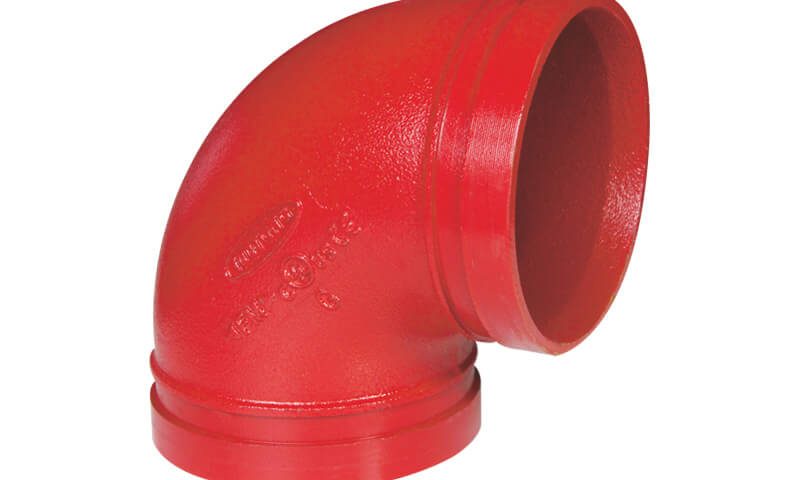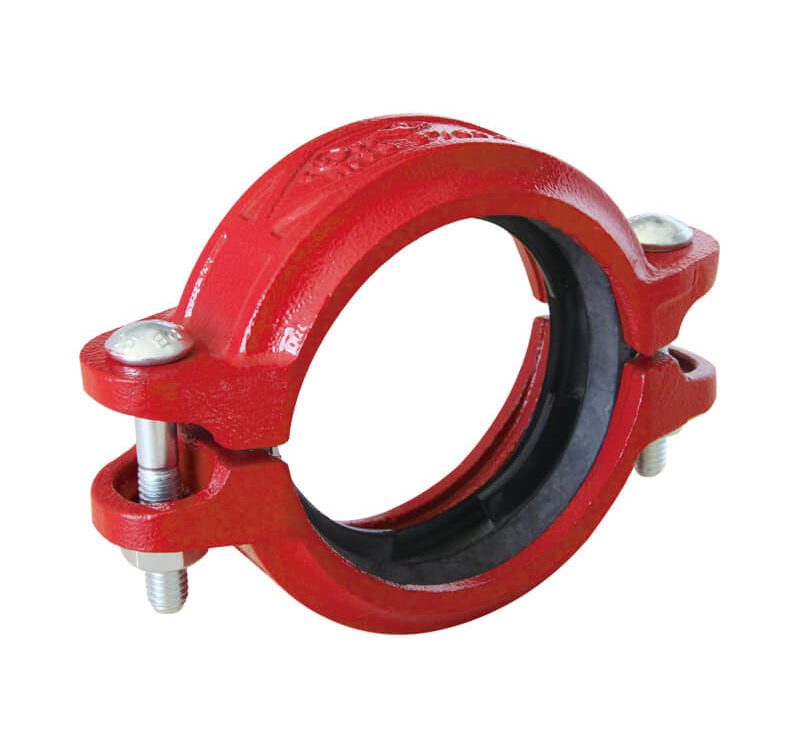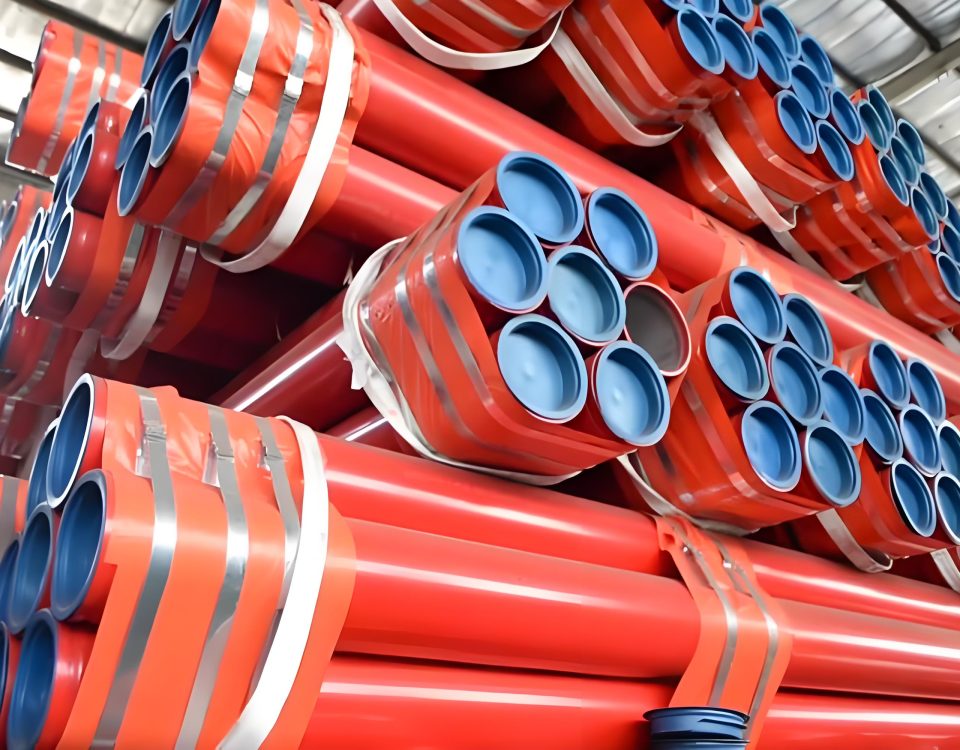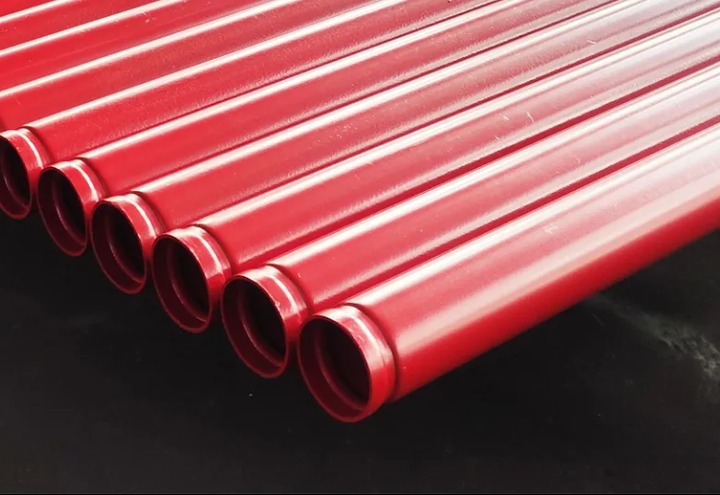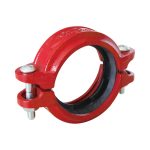
Grooved Pipe Coupling Fittings
June 28, 2025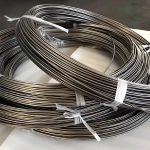
Monel R-405 (UNS N04405) Steel Bar and Rod
July 8, 2025Comprehensive Analysis of Ductile Iron Grooved Pipe Fittings Elbows
Ductile iron grooved pipe fittings elbows are critical components in modern piping systems, offering versatility, reliability, and ease of installation across various applications, including fire protection, waterworks, HVAC, plumbing, gas, and irrigation systems. This article provides an in-depth exploration of grooved 90° elbows, 90° reducing elbows, 45° elbows, 22.5° elbows, and 11.25° elbows, focusing on their specifications, material properties, performance parameters, and comparative analysis.
Product Specifications Overview
Ductile iron grooved pipe fittings elbows are engineered for durability, ease of installation, and compatibility with a wide range of piping systems. Key specifications include:
- Material: Ductile iron ASTM A536, Grade 65-45-12 (tensile strength: 65,000 PSI, yield strength: 45,000 PSI, elongation: 12%).
- Sizes: 1” to 14” (DN25 to DN350).
- Standards: ISO 6182, AWWA C606, GB 5135.11 for dimensions; ASME B36.10, ASTM A53-A53M, ISO 4200 for pipe compatibility.
- Connection: Grooved mechanical coupling, compatible with standard grooved pipes.
- Thread (if applicable): ISO 7-1, BS 21, BSPT, NPT, ASME B1.20.1.
- Pressure Rating: 175 PSI to 500 PSI, depending on size and application.
- Surface Treatment: Red painting, epoxy coating, hot-dip galvanizing, or electroplating for corrosion resistance.
- Bolts and Nuts: ASTM A449, Class 8.8, ISO 898 for high-strength connections.
- Gasket Options: EPDM (water systems), nitrile (oil/gas), silicone rubber (high-temperature applications).
- Certifications: UL Listed, FM Approved for fire protection and critical applications.
- Applications: Fire protection, waterworks, HVAC, plumbing, gas, irrigation, and other piping systems.
The following tables provide detailed size information for each elbow type, including nominal size, outside diameter (OD), and center-to-end (C-E) dimensions, which are critical for system design and installation planning.
Introduction to Ductile Iron Grooved Elbows
Ductile iron grooved pipe fittings elbows are engineered to facilitate directional changes in piping systems while maintaining structural integrity and leak-proof connections. These fittings are manufactured from ductile iron per ASTM A536, Grade 65-45-12, a material known for its high strength, ductility, and corrosion resistance. The grooved design allows for quick and secure installation, reducing labor costs and downtime compared to traditional welded or threaded connections. Available in sizes ranging from 1” to 14” (DN25 to DN350), these elbows conform to international standards such as ISO 6182, AWWA C606, and GB 5135.11, ensuring compatibility with global piping systems.
The grooved system relies on a mechanical coupling mechanism, where the pipe ends are grooved and joined using a coupling that houses a gasket (typically EPDM, nitrile, or silicone rubber) and is secured with bolts and nuts (ASTM A449, Class 8.8, ISO 898). This design accommodates pressure ratings from 175 PSI to 500 PSI, making it suitable for diverse applications, including high-pressure fire protection systems and low-pressure irrigation networks. Surface treatments like red painting, epoxy coating, hot-dip galvanizing, or electroplating enhance durability and resistance to environmental factors. Certifications such as UL Listed and FM Approved further validate their reliability in critical applications.
This section explores the unique characteristics of each elbow type—90° elbow, 90° reducing elbow, 45° elbow, 22.5° elbow, and 11.25° elbow—focusing on their design, performance, and application-specific advantages. By analyzing their dimensions, material properties, and pressure-handling capabilities, we aim to provide a comprehensive guide for engineers, contractors, and facility managers selecting the right fittings for their projects.
Grooved 90° Elbow: Design and Applications
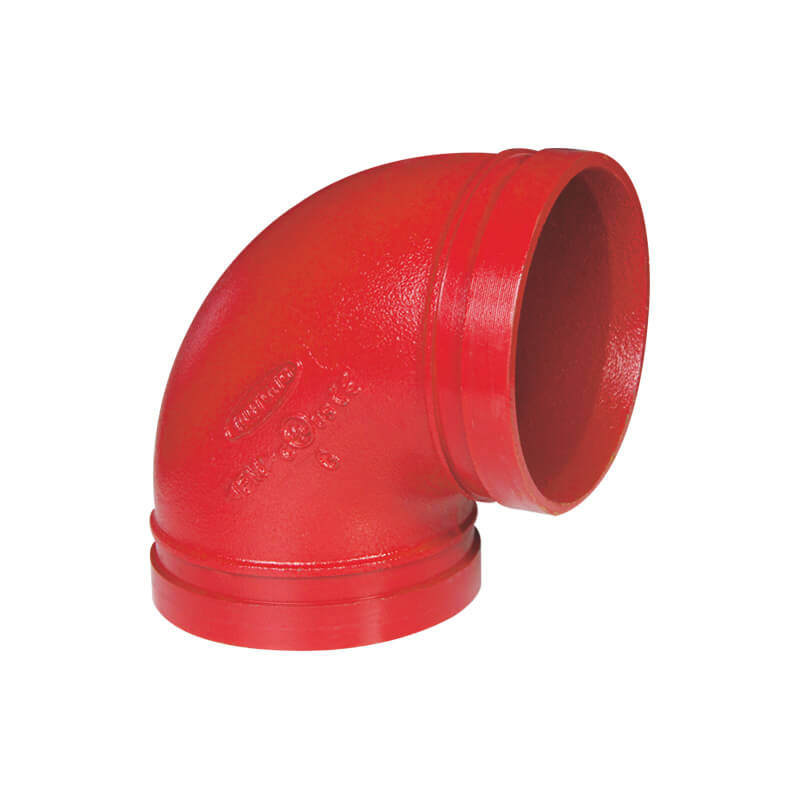
Grooved 90° Elbow Size Table
The grooved 90° elbow facilitates a 90-degree change in flow direction, commonly used in fire protection, HVAC, and plumbing systems. The table below lists available sizes and dimensions, adhering to ISO 6182 and AWWA C606 standards.
| Nominal Size (in) | DN (mm) | Outside Diameter (mm) | Center-to-End (C-E, mm) | Weight (kg) |
|---|---|---|---|---|
| 1 | 25 | 33.7 | 57 | 0.4 |
| 1.25 | 32 | 42.4 | 64 | 0.6 |
| 1.5 | 40 | 48.3 | 70 | 0.8 |
| 2 | 50 | 60.3 | 76 | 1.1 |
| 2.5 | 65 | 73.0 | 83 | 1.6 |
| 3 | 80 | 88.9 | 89 | 2.2 |
| 4 | 100 | 114.3 | 102 | 3.5 |
| 5 | 125 | 141.3 | 114 | 5.2 |
| 6 | 150 | 168.3 | 127 | 7.0 |
| 8 | 200 | 219.1 | 152 | 12.0 |
| 10 | 250 | 273.0 | 178 | 19.5 |
| 12 | 300 | 323.9 | 203 | 28.0 |
| 14 | 350 | 355.6 | 216 | 34.5 |
Notes: Weights are approximate and may vary based on surface treatment. Dimensions are based on standard groove specifications per AWWA C606.
The grooved 90° elbow is a cornerstone of piping systems, enabling a full 90-degree change in flow direction. This fitting is essential in applications requiring sharp turns, such as fire protection systems, HVAC networks, and industrial plumbing. Its design adheres to standards like ISO 6182 and AWWA C606, ensuring precise groove dimensions and compatibility with standard grooved couplings. Available in sizes from 1” to 14” (DN25 to DN350), the 90° elbow accommodates a wide range of pipe diameters, making it versatile for both small-scale plumbing and large-scale industrial systems.
The material, ductile iron ASTM A536 Grade 65-45-12, offers a tensile strength of 65,000 PSI, yield strength of 45,000 PSI, and 12% elongation, providing a balance of strength and flexibility. This allows the elbow to withstand high-pressure conditions (up to 500 PSI) and dynamic loads, such as those encountered in fire sprinkler systems. The grooved connection simplifies installation, eliminating the need for welding or threading, which reduces installation time by up to 50% compared to traditional methods, according to industry studies.
Surface treatments play a critical role in extending the elbow’s lifespan. Red painting and epoxy coating provide a robust barrier against corrosion, while hot-dip galvanizing offers superior protection in harsh environments, such as outdoor waterworks or chemical plants. Electroplating, though less common, enhances aesthetic appeal and provides moderate corrosion resistance for indoor applications. The choice of gasket—EPDM for water systems, nitrile for oil or gas, or silicone for high-temperature applications—further tailors the elbow’s performance to specific project requirements.
In fire protection systems, the 90° elbow’s UL Listed and FM Approved certifications ensure compliance with stringent safety standards. Its ability to handle pressures from 175 PSI to 500 PSI makes it suitable for both low-pressure water distribution and high-pressure fire suppression systems. For HVAC applications, the elbow’s compact design minimizes space requirements, allowing for efficient routing in tight mechanical rooms. However, its sharp 90-degree angle can lead to higher pressure drops compared to shallower angles like 45° or 22.5°, which may influence system efficiency in high-flow scenarios. Engineers must weigh these factors when designing systems to optimize flow dynamics and energy efficiency.
Grooved 90° Reducing Elbow: Versatility in Piping Transitions

Grooved 90° Reducing Elbow Size Table
The grooved 90° reducing elbow allows a 90-degree turn while transitioning between different pipe diameters, ideal for waterworks and industrial piping. The table below provides size combinations and dimensions.
| Nominal Size (in) | DN (mm) | OD (Large End, mm) | OD (Small End, mm) | Center-to-End (Large End, mm) | Center-to-End (Small End, mm) | Weight (kg) |
|---|---|---|---|---|---|---|
| 1.5 x 1 | 40 x 25 | 48.3 | 33.7 | 70 | 57 | 0.7 |
| 2 x 1.5 | 50 x 40 | 60.3 | 48.3 | 76 | 70 | 1.2 |
| 2.5 x 2 | 65 x 50 | 73.0 | 60.3 | 83 | 76 | 1.8 |
| 3 x 2.5 | 80 x 65 | 88.9 | 73.0 | 89 | 83 | 2.5 |
| 4 x 3 | 100 x 80 | 114.3 | 88.9 | 102 | 89 | 4.0 |
| 6 x 4 | 150 x 100 | 168.3 | 114.3 | 127 | 102 | 8.0 |
| 8 x 6 | 200 x 150 | 219.1 | 168.3 | 152 | 127 | 14.0 |
| 10 x 8 | 250 x 200 | 273.0 | 219.1 | 178 | 152 | 22.0 |
| 12 x 10 | 300 x 250 | 323.9 | 273.0 | 203 | 178 | 31.0 |
Notes: The table lists common size combinations; custom configurations may be available. Weights vary based on surface treatment and size differential.
The grooved 90° reducing elbow serves a dual purpose: it facilitates a 90-degree change in flow direction while transitioning between two different pipe diameters. This makes it an indispensable component in systems requiring size reduction, such as water distribution networks, industrial process piping, and HVAC systems with varying pipe sizes. Available in sizes from 1” to 14” (DN25 to DN350), the reducing elbow adheres to standards like ASME B36.10 and ASTM A53-A53M, ensuring seamless integration with standard pipe schedules.
The ductile iron construction (ASTM A536, 65-45-12) provides excellent mechanical properties, including high tensile strength and impact resistance, making it suitable for applications with fluctuating pressures or thermal expansion. The grooved connection system, combined with high-strength bolts and nuts (ASTM A449, Class 8.8), ensures a secure and leak-free joint, even under high-pressure conditions up to 500 PSI. The gasket material—EPDM, nitrile, or silicone—must be carefully selected to match the fluid type and operating temperature, ensuring long-term sealing performance.
Compared to the standard 90° elbow, the reducing elbow introduces additional complexity due to the diameter transition. This can result in increased turbulence and pressure loss, particularly in high-velocity systems. Computational fluid dynamics (CFD) studies indicate that reducing elbows can cause a pressure drop of 5-10% higher than standard elbows, depending on the diameter ratio and flow rate. Engineers must account for these losses when designing systems to maintain efficiency and avoid pump overload. However, the reducing elbow’s ability to connect different pipe sizes eliminates the need for additional fittings, reducing material costs and installation complexity.
Surface treatments like epoxy coating or hot-dip galvanizing enhance the elbow’s resistance to corrosion, making it suitable for outdoor or corrosive environments, such as municipal waterworks or chemical processing plants. In fire protection systems, the reducing elbow’s UL Listed and FM Approved certifications ensure compliance with safety standards, while its robust construction supports reliable performance under high-pressure conditions. For irrigation systems, the reducing elbow’s ability to handle varying pipe sizes optimizes water distribution, improving system efficiency and reducing water waste.
Grooved 45° Elbow: Balancing Flow and Efficiency
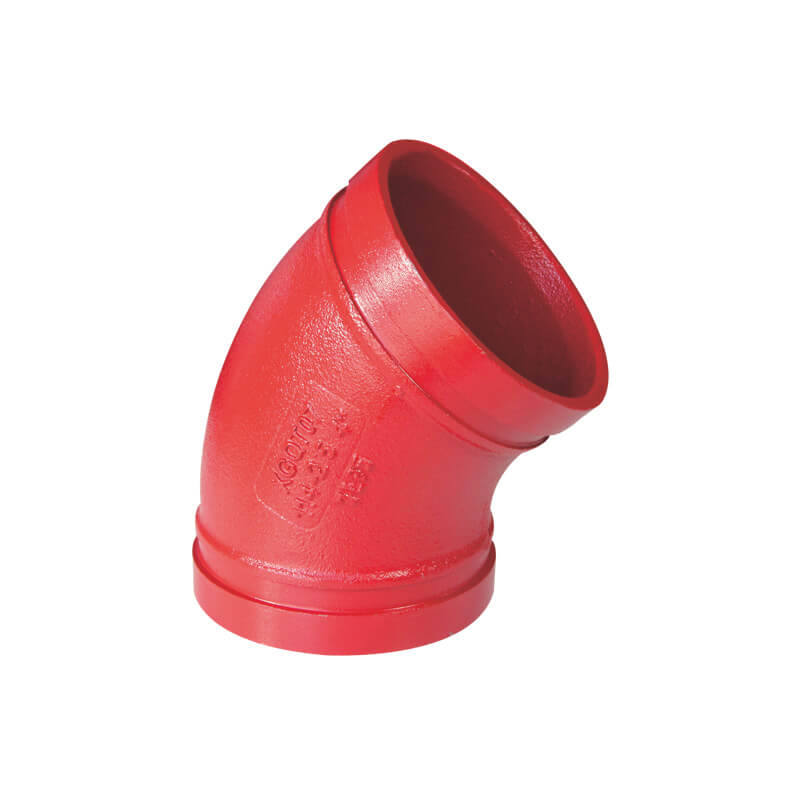
Grooved 45° Elbow Size Table
The grooved 45° elbow provides a gentler 45-degree turn, reducing pressure loss in HVAC, waterworks, and irrigation systems. The table below details available sizes and dimensions
| Nominal Size (in) | DN (mm) | Outside Diameter (mm) | Center-to-End (C-E, mm) | Weight (kg) |
|---|---|---|---|---|
| 1 | 25 | 33.7 | 38 | 0.3 |
| 1.25 | 32 | 42.4 | 41 | 0.4 |
| 1.5 | 40 | 48.3 | 44 | 0.5 |
| 2 | 50 | 60.3 | 48 | 0.7 |
| 2.5 | 65 | 73.0 | 51 | 1.0 |
| 3 | 80 | 88.9 | 57 | 1.4 |
| 4 | 100 | 114.3 | 64 | 2.2 |
| 5 | 125 | 141.3 | 70 | 3.3 |
| 6 | 150 | 168.3 | 76 | 4.5 |
| 8 | 200 | 219.1 | 89 | 7.8 |
| 10 | 250 | 273.0 | 102 | 12.5 |
| 12 | 300 | 323.9 | 114 | 18.0 |
| 14 | 350 | 355.6 | 127 | 22.5 |
Notes: Dimensions are based on AWWA C606 groove standards. Weights are approximate and may vary with surface treatment.
The grooved 45° elbow offers a gentler change in flow direction compared to the 90° elbow, making it ideal for applications where minimizing pressure loss and turbulence is critical. Available in sizes from 1” to 14” (DN25 to DN350), this elbow conforms to standards like ISO 6182 and GB 5135.11, ensuring compatibility with standard grooved couplings and pipes. Its ductile iron construction (ASTM A536, 65-45-12) provides excellent mechanical strength, with a tensile strength of 65,000 PSI and 12% elongation, enabling it to withstand dynamic loads and thermal stresses.
The 45° angle reduces flow resistance compared to a 90° elbow, resulting in lower pressure drops and improved system efficiency. According to fluid dynamics principles, a 45° elbow can reduce pressure loss by up to 30% compared to a 90° elbow in high-velocity systems, making it a preferred choice for HVAC, waterworks, and irrigation systems where energy efficiency is a priority. The grooved connection system simplifies installation, allowing for rapid assembly and disassembly, which is particularly beneficial in maintenance-heavy applications like industrial plumbing.
Surface treatments, such as red painting, epoxy coating, or hot-dip galvanizing, protect the elbow from corrosion and extend its service life in harsh environments. For example, hot-dip galvanizing is recommended for outdoor waterworks, where exposure to moisture and salts can accelerate corrosion. The choice of gasket material—EPDM for water, nitrile for oil or gas, or silicone for high-temperature applications—ensures compatibility with the system’s operating conditions. In fire protection systems, the 45° elbow’s UL Listed and FM Approved certifications guarantee reliability under high-pressure conditions (175-500 PSI).
The 45° elbow’s versatility makes it suitable for a wide range of applications, from fire sprinkler systems to HVAC networks and municipal water distribution. Its ability to balance flow efficiency and structural integrity makes it a cost-effective solution for systems requiring frequent directional changes without significant pressure loss. However, in applications requiring sharper turns, the 90° elbow may be more appropriate, highlighting the importance of application-specific selection.
Grooved 22.5° Elbow: Precision in Subtle Flow Adjustments
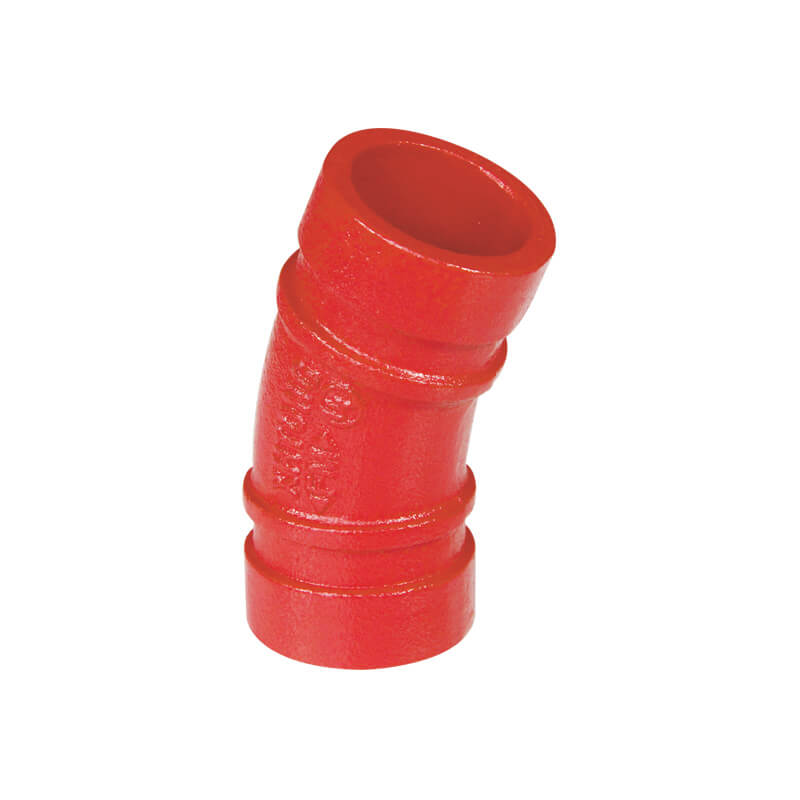
Grooved 22.5° Elbow Size Table
The grooved 22.5° elbow offers a subtle directional change, ideal for energy-efficient systems like HVAC and irrigation. The table below provides size and dimension details
| Nominal Size (in) | DN (mm) | Outside Diameter (mm) | Center-to-End (C-E, mm) | Weight (kg) |
|---|---|---|---|---|
| 1 | 25 | 33.7 | 32 | 0.2 |
| 1.25 | 32 | 42.4 | 35 | 0.3 |
| 1.5 | 40 | 48.3 | 38 | 0.4 |
| 2 | 50 | 60.3 | 41 | 0.6 |
| 2.5 | 65 | 73.0 | 44 | 0.8 |
| 3 | 80 | 88.9 | 48 | 1.1 |
| 4 | 100 | 114.3 | 54 | 1.8 |
| 5 | 125 | 141.3 | 60 | 2.6 |
| 6 | 150 | 168.3 | 67 | 3.5 |
| 8 | 200 | 219.1 | 76 | 6.0 |
| 10 | 250 | 273.0 | 89 | 9.5 |
| 12 | 300 | 323.9 | 102 | 14.0 |
| 14 | 350 | 355.6 | 108 | 17.5 |
Notes: Weights are approximate. Dimensions comply with ISO 4200 and AWWA C606 standards.
The grooved 22.5° elbow is designed for applications requiring precise, subtle changes in flow direction. Available in sizes from 1” to 14” (DN25 to DN350), this elbow adheres to standards like AWWA C606 and ISO 4200, ensuring compatibility with standard grooved systems. Its ductile iron construction (ASTM A536, 65-45-12) provides high strength and durability, making it suitable for both high-pressure (up to 500 PSI) and low-pressure applications, such as irrigation and plumbing systems.
The 22.5° angle minimizes flow disruption, resulting in significantly lower pressure drops compared to 90° or 45° elbows. Fluid dynamics studies suggest that a 22.5° elbow can reduce pressure loss by up to 50% compared to a 90° elbow in high-flow systems, making it an excellent choice for energy-efficient designs. This makes the 22.5° elbow particularly valuable in HVAC systems, where maintaining airflow efficiency is critical, and in irrigation systems, where minimizing water loss is a priority.
The grooved connection system, combined with high-strength bolts and nuts (ASTM A449, Class 8.8), ensures a secure and leak-free joint. Surface treatments like epoxy coating or hot-dip galvanizing enhance corrosion resistance, making the elbow suitable for outdoor or corrosive environments. The choice of gasket material—EPDM, nitrile, or silicone—must align with the system’s fluid type and temperature requirements to ensure long-term performance.
In fire protection systems, the 22.5° elbow’s UL Listed and FM Approved certifications ensure compliance with safety standards, while its compact design allows for flexible routing in confined spaces. For waterworks and irrigation systems, the elbow’s ability to facilitate gradual directional changes optimizes flow distribution, reducing energy costs and improving system efficiency. However, its limited angle may require multiple fittings to achieve larger directional changes, increasing material costs in some applications.
Grooved 11.25° Elbow: Fine-Tuned Flow Control
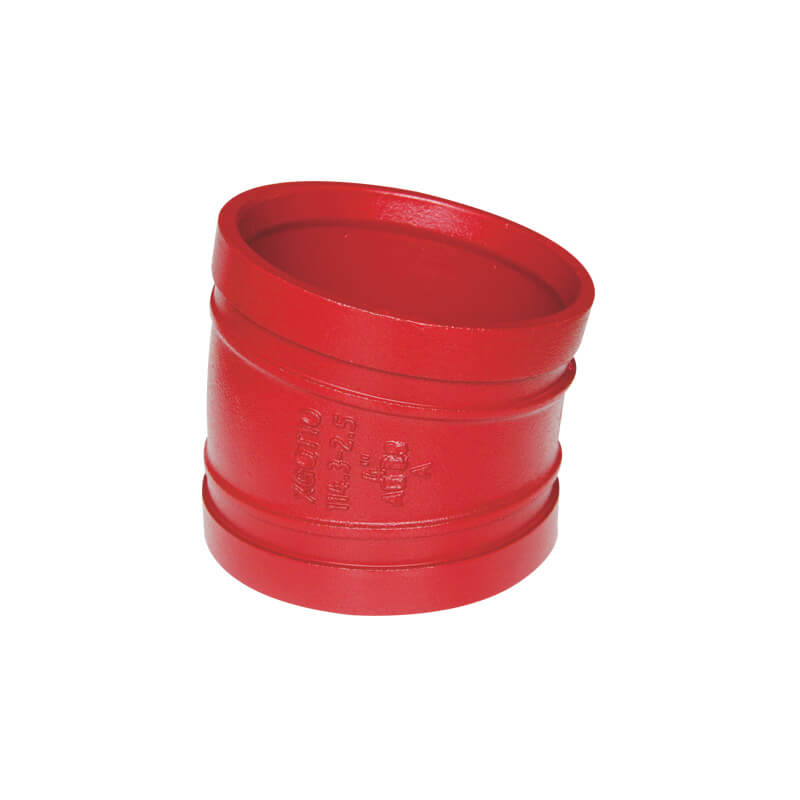
Grooved 11.25° Elbow Size Table
The grooved 11.25° elbow provides the smallest directional change, minimizing pressure loss in waterworks and HVAC systems. The table below lists available sizes and dimensions
| Nominal Size (in) | DN (mm) | Outside Diameter (mm) | Center-to-End (C-E, mm) | Weight (kg) |
|---|---|---|---|---|
| 1 | 25 | 33.7 | 29 | 0.2 |
| 1.25 | 32 | 42.4 | 32 | 0.3 |
| 1.5 | 40 | 48.3 | 35 | 0.4 |
| 2 | 50 | 60.3 | 38 | 0.5 |
| 2.5 | 65 | 73.0 | 41 | 0.7 |
| 3 | 80 | 88.9 | 44 | 1.0 |
| 4 | 100 | 114.3 | 48 | 1.6 |
| 5 | 125 | 141.3 | 54 | 2.3 |
| 6 | 150 | 168.3 | 60 | 3.0 |
| 8 | 200 | 219.1 | 70 | 5.2 |
| 10 | 250 | 273.0 | 83 | 8.5 |
| 12 | 300 | 323.9 | 95 | 12.5 |
| 14 | 350 | 355.6 | 102 | 15.5 |
Notes: Dimensions are based on GB 5135.11 and ISO 6182 standards. Weights are approximate and depend on surface treatment.
The grooved 11.25° elbow is designed for applications requiring minimal directional changes, offering the shallowest angle among grooved elbows. Available in sizes from 1” to 14” (DN25 to DN350), this elbow conforms to standards like ISO 6182 and GB 5135.11, ensuring compatibility with standard grooved systems. Its ductile iron construction (ASTM A536, 65-45-12) provides excellent mechanical properties, including high tensile strength and impact resistance, making it suitable for both high-pressure (up to 500 PSI) and low-pressure applications.
The 11.25° angle minimizes flow turbulence and pressure loss, making it ideal for systems where maintaining flow efficiency is critical, such as HVAC, waterworks, and irrigation networks. Fluid dynamics analysis indicates that an 11.25° elbow can reduce pressure loss by up to 60% compared to a 90° elbow, offering significant energy savings in high-flow systems. The grooved connection system simplifies installation, reducing labor costs and downtime, while high-strength bolts and nuts (ASTM A449, Class 8.8) ensure a secure joint.
Surface treatments like red painting, epoxy coating, or hot-dip galvanizing protect the elbow from corrosion, extending its service life in challenging environments. The choice of gasket material—EPDM for water, nitrile for oil or gas, or silicone for high-temperature applications—ensures compatibility with specific system requirements. In fire protection systems, the 11.25° elbow’s UL Listed and FM Approved certifications guarantee reliability, while its compact design allows for precise routing in complex piping layouts.
The 11.25° elbow’s primary advantage is its ability to provide fine-tuned flow control, making it ideal for applications requiring minimal directional adjustments. However, its limited angle may necessitate multiple fittings for larger directional changes, increasing material and installation costs. Engineers must balance these factors when selecting the 11.25° elbow for specific applications, ensuring optimal performance and cost-effectiveness.
Comparative Analysis and Selection Criteria
The choice of grooved elbow depends on several factors, including the required angle of flow change, pressure rating, pipe size, fluid type, and environmental conditions. The table below summarizes the key specifications and performance characteristics of each elbow type, providing a clear comparison for engineers and contractors.
| Elbow Type | Angle | Size Range | Pressure Rating | Material | Standards | Applications | Pressure Loss |
|---|---|---|---|---|---|---|---|
| 90° Elbow | 90° | 1”-14” (DN25-DN350) | 175-500 PSI | Ductile Iron ASTM A536 | ISO 6182, AWWA C606, GB 5135.11 | Fire Protection, HVAC, Plumbing | High |
| 90° Reducing Elbow | 90° | 1”-14” (DN25-DN350) | 175-500 PSI | Ductile Iron ASTM A536 | ASME B36.10, ASTM A53-A53M | Waterworks, Industrial Piping, HVAC | High (5-10% more) |
| 45° Elbow | 45° | 1”-14” (DN25-DN350) | 175-500 PSI | Ductile Iron ASTM A536 | ISO 6182, GB 5135.11 | HVAC, Waterworks, Irrigation | Moderate (30% less than 90°) |
| 22.5° Elbow | 22.5° | 1”-14” (DN25-DN350) | 175-500 PSI | Ductile Iron ASTM A536 | AWWA C606, ISO 4200 | HVAC, Irrigation, Fire Protection | Low (50% less than 90°) |
| 11.25° Elbow | 11.25° | 1”-14” (DN25-DN350) | 175-500 PSI | Ductile Iron ASTM A536 | ISO 6182, GB 5135.11 | HVAC, Waterworks, Irrigation | Very Low (60% less than 90°) |
When selecting an elbow, engineers must consider the trade-offs between flow efficiency, installation complexity, and cost. The 90° elbow is ideal for sharp turns but introduces higher pressure losses, making it less suitable for high-flow systems. The 90° reducing elbow is essential for size transitions but requires careful design to minimize turbulence. The 45°, 22.5°, and 11.25° elbows offer progressively lower pressure losses, making them ideal for energy-efficient systems, but they may require multiple fittings for larger directional changes, increasing material costs.
Environmental factors also play a critical role. Hot-dip galvanizing is recommended for outdoor or corrosive environments, while epoxy coating is sufficient for indoor applications. The choice of gasket material must align with the fluid type and temperature to ensure long-term sealing performance. For high-pressure applications like fire protection, all elbows meet UL Listed and FM Approved standards, ensuring reliability and safety.
Conclusion
Ductile iron grooved pipe fittings elbows—90°, 90° reducing, 45°, 22.5°, and 11.25°—offer a versatile and reliable solution for modern piping systems. Their ductile iron construction, adherence to international standards, and robust surface treatments ensure durability and performance across diverse applications, from fire protection to irrigation. By understanding the unique characteristics of each elbow type and their impact on flow dynamics, engineers can make informed decisions to optimize system efficiency, safety, and cost-effectiveness. The grooved connection system simplifies installation, while certifications like UL Listed and FM Approved guarantee reliability in critical applications. Whether navigating sharp turns or fine-tuning flow direction, these elbows provide the flexibility and performance needed for today’s complex piping challenges.

